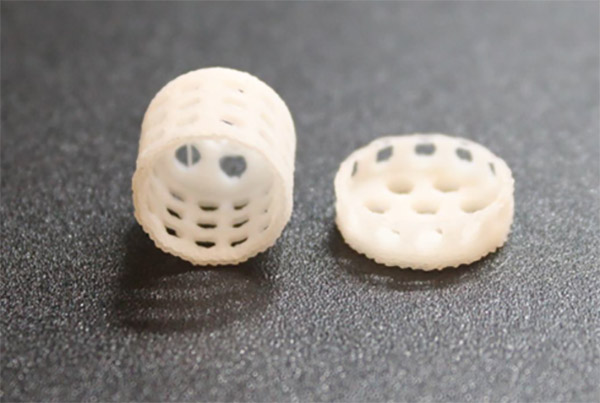
Jason Spector, MD, FACS
Generating a more natural nipple with lasting projection for patients undergoing breast reconstruction surgery after a mastectomy is a key factor in women’s long-term satisfaction with reconstructed breasts. Jason A. Spector, MD, FACS, Chief of the Division of Plastic and Reconstructive Surgery at NewYork-Presbyterian/Weill Cornell Medicine, has developed a novel approach using 3D-printed scaffolds made of a commonly used, bio-absorbable polymer, called Poly-4-Hydroxybutyrate (P4HB), that provides a structure to promote tissue ingrowth. A pre-clinical study, published in Plastic and Reconstructive Surgery on March 8, found that the scaffold maintains the shape and properties of native human nipples for a year with few complications.
“There's lots of anecdotal data as well as peer-reviewed evidence to show that many women don't feel their breasts have been fully reconstructed, if you don't reconstruct the nipples,” says Dr. Spector. “It's absolutely crucial to the woman not only to have this final stage of the reconstruction, but to have it be natural and long lasting.”
“There's lots of anecdotal data as well as peer-reviewed evidence to show that many women don't feel their breasts have been fully reconstructed, if you don't reconstruct their nipples. It's absolutely crucial to the woman not only to have this final stage of the reconstruction, but to have it be natural and long lasting.” — Dr. Jason A. Spector
The Quest for a Realistic Nipple
Creating satisfactory nipples isn’t easy. “In almost every case, whether you do breast reconstruction using either the patient's own tissues or based on a prosthetic implant, there's always adjacent skin available to make the nipple,” says Dr. Spector. “The problem is, as the newly reconstructed nipple (made from the local skin) heals, it almost always contracts and you can get a significant loss of projection or even complete flattening of the reconstructed nipple. I've seen plenty of patients where it’s either flat or only a millimeter or two in projection.”
Filler materials (such as those used in the face and lips) may be used to augment the shape, but they dissipate over time. There are also collagen-based products on the market designed to mitigate the loss of projection. “But even these products lose 70% of their projection the first year,” Dr. Spector says. And stiffer materials like cartilage are uncomfortable.
The beauty of P4HB is that surgeons can tune the rate of the cylinder’s degradation based on its design and how porous it is, which correlates with how rapidly the tissue grows into it, Dr. Spector says.
“We want the cylinder to degrade on a time course that will allow it to counteract the contracture of the skin that happens in the first two to three months of healing,” he says. “So, the device acts as a scaffold not only for tissue ingrowth, but also resists the contracture.” After three or four months, the structure softens significantly, but that’s past the point where contracting forces can deform or flatten it.
Other qualities make P4HB ideal for reconstructing nipples. Although it is a foreign material, its innate properties induce a regenerative response from the body, says Dr. Spector.
The device is designed as a latticework of filaments. “The cells in the body can sense the size of the filaments, believe it or not, and can also sense the size of the pores between the filaments,” Dr. Spector says. “Those dimensional qualities also contribute to whether or not the body rejects it or incorporates it into the body.”
Promising Research
To test the 3D-printed scaffolds, the devices were investigated in an animal model. After six months, fat and vascular tissue resembling that in human breast and nipple tissue, had replaced the polymer scaffolding. A second investigation designed to shorten the time for the scaffolding to dissolve was recently completed with positive results. Human trials can begin once the devices receive approval.

3D-printed P4HB empty scaffold for nipple reconstruction
(Image courtesy of the Spector lab)
“The material has functioned in a predictably positive way,” Dr. Spector says. “I am highly optimistic that because of its success in the preclinical work and the long track record of safety of this material in other clinical applications that it would be something that can be translated relatively easily, keeping in mind that any new device must overcome years of regulatory hurdles and approvals.”
“I’m hopeful this technique will solve the problem of loss of nipple projection that inevitably occurs over time after surgery. I think it will be a very significant improvement over what we have now.” — Dr. Jason A. Spector
The polymer devices might eventually come in standard sizes for use in breast reconstruction or could be designed to match a patient’s remaining nipple if only one breast requires reconstruction. “Conceivably you could print up the size you need,” says Dr. Spector. The only potential downside, he says, is that the reconstructed nipple might be a little firm in the first few months before the material starts to degrade.
“I’m hopeful this technique will solve the problem of loss of nipple projection that inevitably occurs over time after surgery,” Dr. Spector says. “I think it will be a very significant improvement over what we have now.”



